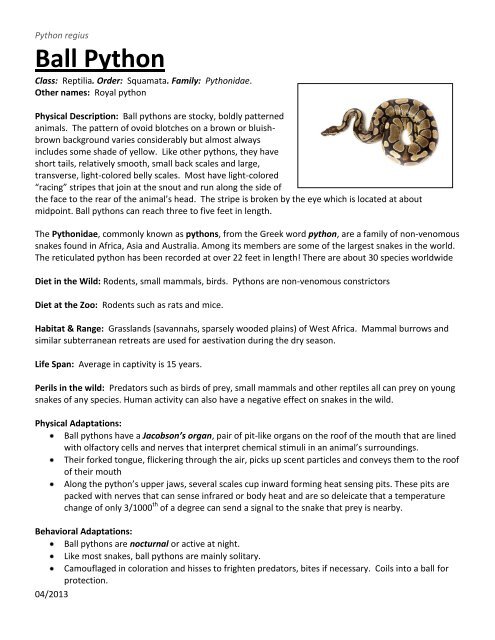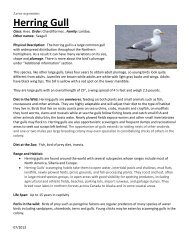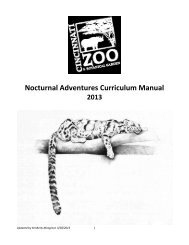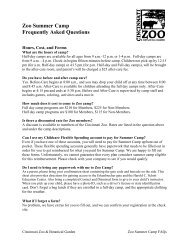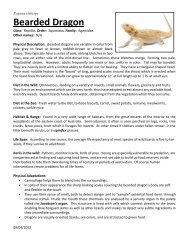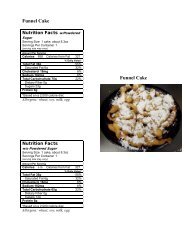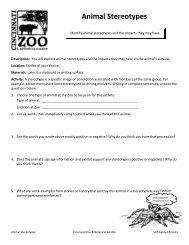Ball Python - The Cincinnati Zoo & Botanical Garden
Ball Python - The Cincinnati Zoo & Botanical Garden
Ball Python - The Cincinnati Zoo & Botanical Garden
Create successful ePaper yourself
Turn your PDF publications into a flip-book with our unique Google optimized e-Paper software.
<strong>Python</strong> regius<strong>Ball</strong> <strong>Python</strong>Class: Reptilia. Order: Squamata. Family: <strong>Python</strong>idae.Other names: Royal pythonPhysical Description: <strong>Ball</strong> pythons are stocky, boldly patternedanimals. <strong>The</strong> pattern of ovoid blotches on a brown or bluishbrownbackground varies considerably but almost alwaysincludes some shade of yellow. Like other pythons, they haveshort tails, relatively smooth, small back scales and large,transverse, light-colored belly scales. Most have light-colored“racing” stripes that join at the snout and run along the side ofthe face to the rear of the animal’s head. <strong>The</strong> stripe is broken by the eye which is located at aboutmidpoint. <strong>Ball</strong> pythons can reach three to five feet in length.<strong>The</strong> <strong>Python</strong>idae, commonly known as pythons, from the Greek word python, are a family of non-venomoussnakes found in Africa, Asia and Australia. Among its members are some of the largest snakes in the world.<strong>The</strong> reticulated python has been recorded at over 22 feet in length! <strong>The</strong>re are about 30 species worldwideDiet in the Wild: Rodents, small mammals, birds. <strong>Python</strong>s are non-venomous constrictorsDiet at the <strong>Zoo</strong>: Rodents such as rats and mice.Habitat & Range: Grasslands (savannahs, sparsely wooded plains) of West Africa. Mammal burrows andsimilar subterranean retreats are used for aestivation during the dry season.Life Span: Average in captivity is 15 years.Perils in the wild: Predators such as birds of prey, small mammals and other reptiles all can prey on youngsnakes of any species. Human activity can also have a negative effect on snakes in the wild.Physical Adaptations:<strong>Ball</strong> pythons have a Jacobson’s organ, pair of pit-like organs on the roof of the mouth that are linedwith olfactory cells and nerves that interpret chemical stimuli in an animal’s surroundings.<strong>The</strong>ir forked tongue, flickering through the air, picks up scent particles and conveys them to the roofof their mouthAlong the python’s upper jaws, several scales cup inward forming heat sensing pits. <strong>The</strong>se pits arepacked with nerves that can sense infrared or body heat and are so deleicate that a temperaturechange of only 3/1000 th of a degree can send a signal to the snake that prey is nearby.Behavioral Adaptations:<strong>Ball</strong> pythons are nocturnal or active at night.Like most snakes, ball pythons are mainly solitary.Camouflaged in coloration and hisses to frighten predators, bites if necessary. Coils into a ball forprotection.04/2013
Jacobson’s organ- A pair of pit-like organs on the roof of the mouth that are lined with olfactory cells andnerves that interpret chemical stimuli in an animal’s surroundings.oviparity - Reproduction in which the eggs are released by the female; development of the offspring occursoutside the maternal body. Adj., oviparousSources:<strong>Cincinnati</strong> <strong>Zoo</strong> & <strong>Botanical</strong> <strong>Garden</strong>shttp://www.backwaterreptiles.comHickman, C.P. Roberts, L.S. 1994. Biology of AnimalsHalliday, T. Adler, K. 1986. <strong>The</strong> Encyclopedia of Reptiles and Amphibians.04/2013


